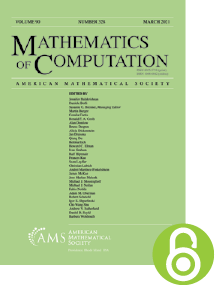Ten consecutive primes in arithmetic progression
HTML articles powered by AMS MathViewer
- by H. Dubner, T. Forbes, N. Lygeros, M. Mizony, H. Nelson and P. Zimmermann PDF
- Math. Comp. 71 (2002), 1323-1328 Request permission
Abstract:
In 1967 the first set of 6 consecutive primes in arithmetic progression was found. In 1995 the first set of 7 consecutive primes in arithmetic progression was found. Between November, 1997 and March, 1998, we succeeded in finding sets of 8, 9 and 10 consecutive primes in arithmetic progression. This was made possible because of the increase in computer capability and availability, and the ability to obtain computational help via the Internet. Although it is conjectured that there exist arbitrarily long sequences of consecutive primes in arithmetic progression, it is very likely that 10 primes will remain the record for a long time.References
- M. Balazard & A. Vavoda, Division euclidienne, Pour la Science 239, septembre 1997.
- H. Dubner, The Size of Prime Factorials, J. Recreational Math. 19(1), 1987, pp. 743-749.
- Harvey Dubner and Harry Nelson, Seven consecutive primes in arithmetic progression, Math. Comp. 66 (1997), no. 220, 1743–1749. MR 1423071, DOI 10.1090/S0025-5718-97-00875-2
- Richard K. Guy, Unsolved problems in number theory, 2nd ed., Problem Books in Mathematics, Springer-Verlag, New York, 1994. Unsolved Problems in Intuitive Mathematics, I. MR 1299330, DOI 10.1007/978-1-4899-3585-4
- L. J. Lander and T. R. Parkin, On first appearance of prime differences, Math. Comp. 21 (1967), 483–488. MR 230677, DOI 10.1090/S0025-5718-1967-0230677-4
- N. Lygeros & M. Mizony & P. Zimmermann, Sur la division euclidienne d’un nombre premier par son rang, Journée de Mathématiques Effectives, Départment de Mathématiques de l’Université Jean Monnet, Nov. 1998.
- H. L. Nelson, There is a Better Sequence, J. Recreational Math. 8(1), 1975, pp. 39-43.
- S. Weintraub, Consecutive Primes in Arithmetic Progression, J. Recreational Math. 25(3), 1993, pp. 169-171.
Additional Information
- H. Dubner
- Affiliation: 449 Beverly Road, Ridgewood, New Jersey 07450
- Email: hdubner1@compuserve.com
- T. Forbes
- Affiliation: 22 St. Albans Road, Kingston upon Thames, Surrey, KT2 5HQ England
- Email: tonyforbes@ltkz.demon.co.uk
- N. Lygeros
- Affiliation: Institut Girard, Cnr Upres-A 502B, Université Lyon I 43 Bd Du 11 Novembre 1918, 69622 Villeurbanne Cedex, France
- Email: lygeros@desargues.univ-lyon1.fr
- M. Mizony
- Affiliation: Institut Girard, Cnr Upres-A 502B, Université Lyon I 43 Bd Du 11 Novembre 1918, 69622 Villeurbanne Cedex, France
- Email: mizony@desargues.univ-lyon1.fr
- H. Nelson
- Affiliation: 4259 Emory Way, Livermore, California 94550
- Email: hlnel@flash.net
- P. Zimmermann
- Affiliation: Inria Lorraine, Technopole de Nancy-Brabois, 615 Rue Du Jardin Botanique Bp 101, F-54600 Villers-Lès-Nancy, France
- MR Author ID: 273776
- Email: zimmerma@loria.fr
- Received by editor(s): June 22, 1998
- Received by editor(s) in revised form: October 10, 2000
- Published electronically: November 28, 2001
- © Copyright 2001 American Mathematical Society
- Journal: Math. Comp. 71 (2002), 1323-1328
- MSC (2000): Primary 11N13
- DOI: https://doi.org/10.1090/S0025-5718-01-01374-6
- MathSciNet review: 1898760


